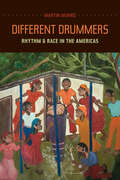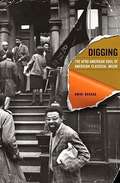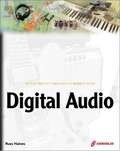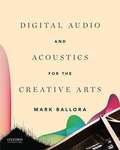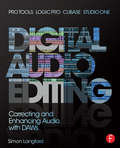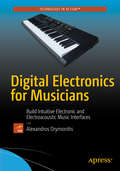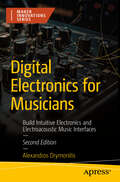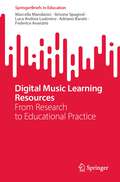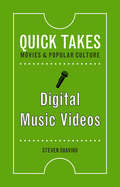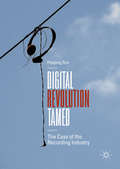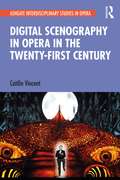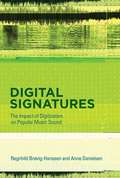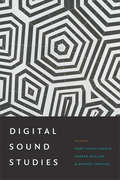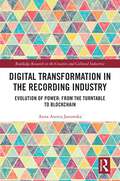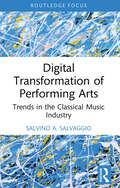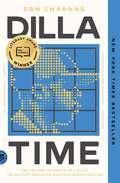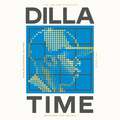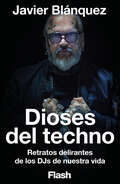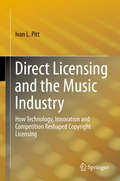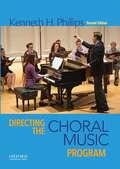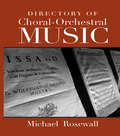- Table View
- List View
Different Drummers: Rhythm and Race in the Americas (Music of the African Diaspora #14)
by Martin MunroLong a taboo subject among critics, rhythm finally takes center stage in this book's dazzling, wide-ranging examination of diverse black cultures across the New World. Martin Munro’s groundbreaking work traces the central—and contested—role of music in shaping identities, politics, social history, and artistic expression. Starting with enslaved African musicians, Munro takes us to Haiti, Trinidad, the French Caribbean, and to the civil rights era in the United States. Along the way, he highlights such figures as Toussaint Louverture, Jacques Roumain, Jean Price-Mars, The Mighty Sparrow, Aimé Césaire, Edouard Glissant, Joseph Zobel, Daniel Maximin, James Brown, and Amiri Baraka. Bringing to light new connections among black cultures, Munro shows how rhythm has been both a persistent marker of race as well as a dynamic force for change at virtually every major turning point in black New World history.
Dig If You Will the Picture: Funk, Sex, God, & Genius in the Music of Prince
by Ben GreenmanNamed one of the best music books of 2017 by The Wall Street JournalA unique and kaleidoscopic look into the life, legacy, and electricity of the pop legend Prince and his wideranging impact on our cultureBen Greenman, New York Times bestselling author, contributing writer to the New Yorker, and owner of thousands of recordings of Prince and Prince-related songs, knows intimately that there has never been a rock star as vibrant, mercurial, willfully contrary, experimental, or prolific as Prince. Uniting a diverse audience while remaining singularly himself, Prince was a tireless artist, a musical virtuoso and chameleon, and a pop-culture prophet who shattered traditional ideas of race and gender, rewrote the rules of identity, and redefined the role of sex in pop music.A polymath in his own right who collaborated with George Clinton and Questlove on their celebrated memoirs, Greenman has been listening to and writing about Prince since the mid-eighties. Here, with the passion of an obsessive fan and the skills of a critic, journalist, and novelist, he mines his encyclopedic knowledge of Prince’s music to tell both his story and the story of the paradigm-shifting ideas that he communicated to his millions of fans around the world. Greenman's take on Prince is the autobiography of a generation and its ideas. Asking a series of questions—not only “Who was Prince?” but “Who wasn’t he?” and “Who are we?”—Dig if You Will the Picture is a fitting tribute to an extraordinary talent.
Digging: The Afro-American Soul of American Classical Music
by Amiri BarakaIn this book on music, the author blends autobiography, history, musical analysis, and political commentary to recall the sounds, people, times, and places he has encountered. He brings home how musicians carry and extend that knowledge with a sense of meaning and belonging.
Digital Audio
by Russ HainesProfessional audio secrets shared! Digital Audio teaches how to create high-quality audio and prepare it for your audience -- from audio CDs to streaming on the Internet. Learn what really makes a difference in digital audio and what doesn't. From the microphone to streamed audio, this book explains how to get professional results. The techniques, tips, and tricks used by the pros will keep you ahead of the rest of the pack even after the next software revision. The accompanying CD-ROM contains software for Sound Forge 5.0, Logic Audio (both Macintosh & Windows platforms), Cakewalk Pro Audio v9, Cool Edit 2000, ACID 2.0, and Cubase VST, plus CD audio examples from the book, and a comprehensive collection of the same audio examples compressed in all the useful streaming formats and at various bandwidths, allowing you to decide what works best.
Digital Audio And Acoustics For The Creative Arts
by Mark BalloraDesigned for introductory courses in electronic music and multimedia, Digital Audio and Acoustics for the Creative Arts presents the fundamental concepts of musical acoustics, psychoacoustics, electronics, digital audio, audio recording, and communication among devices via the Musical Instrument Digital Interface (MIDI) and Open Sound Control (OSC).
Digital Audio Editing: Correcting and Enhancing Audio in Pro Tools, Logic Pro, Cubase, and Studio One
by Simon LangfordWhether you’re comping a vocal track, restoring an old recording, working with dialogue or sound effects for film, or imposing your own vision with mash-ups or remixes, audio editing is a key skill to successful sound production. Digital Audio Editing gives you the techniques, from the simplest corrective editing like cutting, copying, and pasting to more complex creative editing, such as beat mapping and time-stretching. You’ll be able to avoid unnatural-sounding pitch correction and understand the potential pitfalls you face when restoring classic tracks. Author Simon Langford invites you to see editing with his wide-angle view, putting this skill into a broad context that will inform your choices even as you more skillfully manipulate sound. Focusing on techniques applicable to any digital audio workstation, it includes break-outs giving specific keystrokes and instruction in Avid’s Pro Tools, Apple’s Logic Pro, Steinberg’s Cubase, and PreSonus’s Studio One. The companion websites includes tutorials in all four software packages to help you immediately apply the broad skills from the book.
Digital Electronics for Musicians
by Alexandros DrymonitisDigital Electronics for Musicians is the perfect book for musicians who want to dive into the world of computer music and physical computing. This book is aimed at adventurous musicians who want to learn about music programming with Arduino, sensors, and Pure Data, and how to make new interfaces and even new instruments with that knowledge. You'll learn the basics of the Pure Data and Arduino languages, how to incorporate sensors into your musical projects, and how to use embedded computers, like the Raspberry Pi, to create stand-alone projects. Along the way, you'll learn how to create a variety of innovative (Mark, Michelle, I guess they are innovative, but not 100% sure) musical projects, including an interactive bow for stringed instruments, a MIDI clavier synthesizer, an interactive drum set, a patch-bay matrix synthesizer, a guitar looper, and even a DIY theremin. If you are a musician or tinkerer who wants to explore the world of electronic and electroacoustic music and musical interfaces with Arduino, sensors, and Pure Data, Digital Electronics for Musicians is the book for you. What you'll learn Learn the basics of the Pure Data and the Arduino languages Learn more about the available sensors on the market, and how you can incorporate them into your musical projects Focus on physical computing by combining Arduino and Pure Data, bringing the physical world to the world of the computers Make use of additional libraries that extend the capabilities of the Arduino Make use of external objects in Pure Data that help achieve certain goals, depending on the project Learn how a Pure Data patch functions and be able to modify other people's work that fits your needs Learn how the Arduino language works, enabling the modification of already existing code, according to your needs Get insight on the serial communication between the Arduino and Pure Data Learn how to approach various programming challenges in different ways Who this book is for Musicians who want to explore the world of electronic and electroacoustic music and musical interfaces with Arduino, sensors, and Pure Data. Table of Contents Chapter 1: Introduction to Pure Data Chapter 2: Intro to Arduino Chapter 3: Embedded computers and going wireless Chapter 4: Getting started with musical applications Chapter 5: A simple synthesizer using a MIDI keyboard and Arduino Chapter 6: An interactive bow Chapter 7: An interactive drum set Chapter 8: A DIY Theremin Chapter 9: Making a looper Chapter 10: A patch-bay matrix synthesizer
Digital Electronics for Musicians: Build Intuitive Electronics and Electroacoustic Music Interfaces (Maker Innovations Series)
by Alexandros DrymonitisDive into the world of computer music and physical computing and stay ahead of the melodic curve. This book is aimed at adventurous musicians who want to learn about music programming with Arduino, sensors, and Pure Data, and how to make new interfaces and instruments with that knowledge. In this updated version, you can expect a wave of updates that bring the content in sync with the latest tech trends. The book now features revamped code and visuals throughout, all tailored to match the cutting-edge versions of Pure Data, Arduino IDE, and the powerful Raspberry Pi 5. What's even more thrilling is the integration of the Bela platform for audio enthusiasts, alongside an expanded wireless toolkit that includes both Wi-Fi and the trusty XBee. To ensure a smoother journey, there are more project-enhancing images to guide you, and a brand-new chapter dedicated to AI, based on the author's innovative neuralnet object for Pure Data, as showcased in the AIMC conference proceedings. You’ll start with the basics of the Pure Data and Arduino languages, how to incorporate sensors into your musical projects, and how to use embedded computers, like the Raspberry Pi, to create stand-alone projects. Along the way, you’ll learn how to create a variety of innovative musical projects, including an interactive glove that can be used bystringed instrumentalists or other musicians, an interactive drum set, a patch-bay matrix synthesizer, a guitar looper, a DIY theremin, and even DIY instruments that incorporate AI. If you are a musician or tinkerer who wants to explore the world of electronic and electroacoustic music, then Digital Electronics for Musicians, Second Edition is the book for you. What You Will Learn Incorporate sensors into your musical projects. Combine Arduino and Pure Data to bring the physical world to computers. Use additional libraries that extend the capabilities of the Arduino. Work with external objects in Pure Data and create your own patches from scratch. Write your own sketches with Arduino. Who This Book Is For Musicians who want to explore the world of electronic and electroacoustic music.
Digital Music Learning Resources: From Research to Educational Practice (SpringerBriefs in Education)
by Marcella Mandanici Simone Spagnol Luca Andrea Ludovico Adriano Baratè Federico AvanziniThis book offers an overview of the complex world of digital materials for music education and of their possible use in the everyday practice of music teachers. It presents a multidimensional taxonomy of digital materials for music education. Through the taxonomy it is possible to derive a clear framework of the whole field and to perform analysis of the state of art. The book shows the use of this flexible and powerful knowledge tool for reviewing the digital materials in the various domains and dimentions. The book provides researchers and designers with an overview of what has already been designed, proposed and tested in the field. It also offers music teachers a wider perspective of the possibilities connected to current technologies in the field of music education, and it suggests possible interrelationships between research and music education practices.
Digital Music Videos
by Steven ShaviroMusic videos today sample and rework a century’s worth of movies and other pop culture artifacts to offer a plethora of visions and sounds that we have never encountered before. As these videos have proliferated online, they have become more widely accessible than ever before. In Digital Music Videos, Steven Shaviro examines the ways that music videos interact with and change older media like movies and gallery art; the use of technologies like compositing, motion control, morphing software, and other digital special effects in order to create a new organization of time and space; how artists use music videos to project their personas; and how less well known musicians use music videos to extend their range and attract attention. Surveying a wide range of music videos, Shaviro highlights some of their most striking innovations while illustrating how these videos are creating a whole new digital world for the music industry.
Digital Revolution Tamed: The Case of the Recording Industry
by Hyojung SunThis book explores why widespread predictions of the radical transformation in the recording industry did not materialise. Although the growing revenue generated from streaming signals the recovery of the digital music business, it is important to ask to what extent is the current development a response to digital innovation. Hyojung Sun finds the answer in the detailed innovation process that has taken place since Napster. She reassesses the way digital music technologies were encultured in complex music valorisation processes and demonstrates how the industry has become reintermediated rather than disintermediated. This book offers a new understanding of digital disruption in the recording industry. It captures the complexity of the innovation processes that brought about technological development, which arose as a result of interaction across the circuit of the recording business – production, distribution, valorisation, and consumption. By offering a more sophisticated account than the prevailing dichotomy, the book exposes deterministic myths surrounding the radical transformation of the industry.
Digital Scenography in Opera in the Twenty-First Century (Ashgate Interdisciplinary Studies in Opera)
by Caitlin VincentDigital Scenography in Opera in the Twenty-First Century is the first definitive study of the use of digital scenography in Western opera production. The book begins by exploring digital scenography’s dramaturgical possibilities and establishes a critical framework for identifying and comparing the use of digital scenography across different digitally enhanced opera productions. The book then investigates the impacts and potential disruptions of digital scenography on opera’s longstanding production conventions, both on and off the stage. Drawing on interviews with major industry practitioners, including Paul Barritt, Mark Grimmer, Donald Holder, Elaine J. McCarthy, Luke Halls, Wendall K. Harrington, Finn Ross, S. Katy Tucker, and Victoria ‘Vita’ Tzykun, author Caitlin Vincent identifies key correlations between the use of digital scenography in practice and subsequent impacts on creative hierarchies, production design processes, and organisational management. The book features detailed case studies of digitally enhanced productions premiered by Dutch National Opera, Komische Oper Berlin, Opéra de Lyon, The Royal Opera, Covent Garden, San Francisco Opera, Santa Fe Opera, Théâtre Royal de la Monnaie, The Metropolitan Opera, Victorian Opera, and Washington National Opera.
Digital Signatures: The Impact of Digitization on Popular Music Sound
by Anne Danielsen Ragnhild Brøvig-HanssenIs digital production killing the soul of music? Is Auto-Tune the nadir of creative expression? Digital technology has changed not only how music is produced, distributed, and consumed but also -- equally important but not often considered -- how music sounds. In this book, Ragnhild Brøvig-Hanssen and Anne Danielsen examine the impact of digitization on the aesthetics of popular music. They investigate sonically distinctive "digital signatures" -- musical moments when the use of digital technology is revealed to the listener. The particular signatures of digital mediation they examine include digital reverb and delay, MIDI and sampling, digital silence, the virtual cut-and-paste tool, digital glitches, microrhythmic manipulation, and autotuning -- all of which they analyze in specific works by popular artists.Combining technical and historical knowledge of music production with musical analyses, aesthetic interpretations, and theoretical discussions, Brøvig-Hanssen and Danielsen offer unique insights into how digitization has changed the sound of popular music and the listener's experience of it. For example, they show how digital reverb and delay have allowed experimentation with spatiality by analyzing Kate Bush's "Get Out of My House"; they examine the contrast between digital silence and the low-tech noises of tape hiss or vinyl crackle in Portishead's "Stranger"; and they describe the development of Auto-Tune -- at first a tool for pitch correction -- into an artistic effect, citing work by various hip-hop artists, Bon Iver, and Lady Gaga.
Digital Signatures: The Impact of Digitization on Popular Music Sound (The\mit Press Ser.)
by Anne Danielsen Ragnhild Brovig-HanssenHow sonically distinctive digital “signatures”—including reverb, glitches, and autotuning—affect the aesthetics of popular music, analyzed in works by Prince, Lady Gaga, and others. Is digital production killing the soul of music? Is Auto-Tune the nadir of creative expression? Digital technology has changed not only how music is produced, distributed, and consumed but also—equally important but not often considered—how music sounds. In this book, Ragnhild Brøvig-Hanssen and Anne Danielsen examine the impact of digitization on the aesthetics of popular music. They investigate sonically distinctive “digital signatures”—musical moments when the use of digital technology is revealed to the listener. The particular signatures of digital mediation they examine include digital reverb and delay, MIDI and sampling, digital silence, the virtual cut-and-paste tool, digital glitches, microrhythmic manipulation, and autotuning—all of which they analyze in specific works by popular artists.Combining technical and historical knowledge of music production with musical analyses, aesthetic interpretations, and theoretical discussions, Brøvig-Hanssen and Danielsen offer unique insights into how digitization has changed the sound of popular music and the listener's experience of it. For example, they show how digital reverb and delay have allowed experimentation with spatiality by analyzing Kate Bush's “Get Out of My House”; they examine the contrast between digital silence and the low-tech noises of tape hiss or vinyl crackle in Portishead's “Stranger”; and they describe the development of Auto-Tune—at first a tool for pitch correction—into an artistic effect, citing work by various hip-hop artists, Bon Iver, and Lady Gaga.
Digital Sound Studies
by Mary Caton Lingold Darren Mueller Whitney TrettienThe digital turn has created new opportunities for scholars across disciplines to use sound in their scholarship. This volume’s contributors provide a blueprint for making sound central to research, teaching, and dissemination. They show how digital sound studies has the potential to transform silent, text-centric cultures of communication in the humanities into rich, multisensory experiences that are more inclusive of diverse knowledges and abilities. Drawing on multiple disciplines—including rhetoric and composition, performance studies, anthropology, history, and information science—the contributors to Digital Sound Studies bring digital humanities and sound studies into productive conversation while probing the assumptions behind the use of digital tools and technologies in academic life. In so doing, they explore how sonic experience might transform our scholarly networks, writing processes, research methodologies, pedagogies, and knowledges of the archive. As they demonstrate, incorporating sound into scholarship is thus not only feasible but urgently necessary. Contributors. Myron M. Beasley, Regina N. Bradley, Steph Ceraso, Tanya Clement, Rebecca Dowd Geoffroy-Schwinden, W. F. Umi Hsu, Michael J. Kramer, Mary Caton Lingold, Darren Mueller, Richard Cullen Rath, Liana M. Silva, Jonathan Sterne, Jennifer Stoever, Jonathan W. Stone, Joanna Swafford, Aaron Trammell, Whitney Trettien
Digital Transformation in The Recording Industry: Evolution of Power: From The Turntable To Blockchain (Routledge Research in the Creative and Cultural Industries)
by Anna Anetta JanowskaThe recording industry has famously been transformed by technology throughout its entire history.The book presents an analysis of these changes using Porter's five forces model. The author highlights the evolution of buyers' and suppliers' power, the emergence of new competitors, product innovation and rivalry between companies in the industry driven by economic, political, social and legal factors.As an early mover in the social diffusion of copyright-sensitive content, the recording industry reflected in this book serves as an important reference for the analysis of other cultural and creative sectors.
Digital Transformation in the Recording Industry: Evolution of Power: From The Turntable To Blockchain (Routledge Research in the Creative and Cultural Industries)
by Anna Anetta JanowskaThe recording industry has famously been transformed by technology throughout its entire history. The book presents an analysis of these changes using Porter's five forces model. The author highlights the evolution of buyers' and suppliers' power, the emergence of new competitors, product innovation and rivalry between companies in the industry driven by economic, political, social and legal factors. As an early mover in the social diffusion of copyright-sensitive content, the recording industry reflected in this book serves as an important reference for the analysis of other cultural and creative sectors.
Digital Transformation of Performing Arts: Trends in the Classical Music Industry (Routledge Focus on Business and Management)
by Salvino A. SalvaggioIn the wake of the COVID-19 pandemic, a combination of hybrid working and cultural consumption, alongside shifting audience tastes, performing arts organisations are dealing with significant challenges around digital transformation (DT). This book explores the DT of performing arts, taking readers on a journey through classical orchestras as illustrative examples.From reimagining audience engagement to revolutionising operations, the book examines how emerging technologies like AI, VR, and blockchain are reshaping the cultural landscape. Through case studies of successful digital initiatives and analysis of critical success factors, readers will gain practical strategies for navigating this complex transition. The author emphasises that successful DT hinges on a clear, comprehensive strategy and a sharp implementation roadmap. Key challenges addressed include balancing tradition with innovation, ethical considerations, and financial sustainability. Notably, the book features numerous summary tables that serve as actionable templates, providing readers with ready-to-use tools to support their own DT efforts. With a forward-looking perspective, the book also explores future trends and research directions.This concise book synthesises fragmented research and practical insights to provide a readable overview for scholars, students, and reflective practitioners. It will also be of value for arts administrators, performers, and cultural policymakers across various disciplines.
Dilla Time: The Life and Afterlife of J Dilla, the Hip-Hop Producer Who Reinvented Rhythm
by Dan CharnasA NEW YORK TIMES BEST SELLER"This book is a must for everyone interested in illuminating the idea of unexplainable genius.” —QUESTLOVEEqual parts biography, musicology, and cultural history, Dilla Time chronicles the life and legacy of J Dilla, a musical genius who transformed the sound of popular music for the twenty-first century.He wasn’t known to mainstream audiences, even though he worked with renowned acts like D’Angelo and Erykah Badu and influenced the music of superstars like Michael Jackson and Janet Jackson. He died at the age of thirty-two, and in his lifetime he never had a pop hit. Yet since his death, J Dilla has become a demigod: revered by jazz musicians and rap icons from Robert Glasper to Kendrick Lamar; memorialized in symphonies and taught at universities. And at the core of this adulation is innovation: a new kind of musical time-feel that he created on a drum machine, but one that changed the way “traditional” musicians play.In Dilla Time, Dan Charnas chronicles the life of James DeWitt Yancey, from his gifted childhood in Detroit, to his rise as a Grammy-nominated hip-hop producer, to the rare blood disease that caused his premature death; and follows the people who kept him and his ideas alive. He also rewinds the histories of American rhythms: from the birth of soul in Dilla’s own “Motown,” to funk, techno, and disco. Here, music is a story of Black culture in America and of what happens when human and machine times are synthesized into something new. Dilla Time is a different kind of book about music, a visual experience with graphics that build those concepts step by step for fans and novices alike, teaching us to “see” and feel rhythm in a unique and enjoyable way.Dilla’s beats, startling some people with their seeming “sloppiness,” were actually the work of a perfectionist almost spiritually devoted to his music. This is the story of the man and his machines, his family, friends, partners, and celebrity collaborators. Culled from more than 150 interviews about one of the most important and influential musical figures of the past hundred years, Dilla Time is a book as delightfully detail-oriented and unique as J Dilla’s music itself.
Dilla Time: The Life and Afterlife of J Dilla, the Hip-Hop Producer Who Reinvented Rhythm
by Dan Charnas'This book is a must for everyone interested in illuminating the idea of unexplainable genius' - QUESTLOVEEqual parts biography, musicology, and cultural history, Dilla Time chronicles the life and legacy of J Dilla, a musical genius who transformed the sound of popular music for the twenty-first century.He wasn't known to mainstream audiences, and when he died at age thirty-two, he had never had a pop hit. Yet since his death, J Dilla has become a demigod, revered as one of the most important musical figures of the past hundred years. At the core of this adulation is innovation: as the producer behind some of the most influential rap and R&B acts of his day, Dilla created a new kind of musical time-feel, an accomplishment on a par with the revolutions wrought by Louis Armstrong and James Brown. Dilla and his drum machine reinvented the way musicians play.In Dilla Time, Dan Charnas chronicles the life of James DeWitt Yancey, from his gifted Detroit childhood to his rise as a sought-after hip-hop producer to the rare blood disease that caused his premature death. He follows the people who kept Dilla and his ideas alive. And he rewinds the histories of American rhythms: from the birth of Motown soul to funk, techno, and disco. Here, music is a story of what happens when human and machine times are synthesized into something new.This is the story of a complicated man and his machines; his family, friends, partners, and celebrity collaborators; and his undeniable legacy. Based on nearly two hundred original interviews, and filled with graphics that teach us to feel and "see" the rhythm of Dilla's beats, Dilla Time is a book as defining and unique as J Dilla's music itself.Financial Times Music Book of the Year 2022
Dimensions of Energy in Shostakovich's Symphonies
by Michael RofeShostakovich's music is often described as being dynamic, energetic. But what is meant by 'energy' in music? After setting out a broad conceptual framework for approaching this question, Michael Rofe proposes various potential sources of the perceived energy in Shostakovich's symphonies, describing also the historical significance of energeticist thought in Soviet Russia during the composer's formative years. The book is in two parts. In Part I, examples are drawn from across the symphonies in order to demonstrate energy streams within various musical dimensions. Three broad approaches are adopted: first, the theories of Boleslav Yavorsky are used to consider melodic-harmonic motion; second, Boris Asafiev's work, with its echoes of Ernst Kurth, is used to describe form as a dynamic process; and third, proportional analysis reveals numerous symmetries and golden sections within local and large-scale temporal structures. In Part II, the multi-dimensionality of musical energy is considered through case studies of individual movements from the symphonies. This in turn gives rise to broader contextualised perspectives on Shostakovich's work. The book ends with a detailed examination of why a piece of music might contain golden sections.
Dioses del Techno: Retratos delirantes de los DJs de nuestra vida (Flash Relatos #Volumen)
by Javier BlánquezUn repaso a las intensas vidas de los DJs más legendarios de nuestros tiempos. Dioses del techno es una compilación de textos en clave satírica que giran alrededor de las vidas de los quince DJs -más unbonus track dedicado a Pocholo- más icónicos y carismáticos de nuestra época: Carl Cox, Sven Väth, Richie Hawtin, Nina Kraviz o Jeff Mills, además del portero más temido del mundo, Sven Marquardt. <P><P>A finales de 2015, Javier Blánquez comenzó a publicar estos perfiles en la revista digital Beatburguer, y tuvieron miles de visitas. Blánzquez no buscaba describir a estas figuras en términos académicos o muy técnicos, sino que intentó descubrir en cada artista las anécdotas más disparatadas, los detalles más escabrosos de sus vidas y los rasgos que, en definitiva, los han hecho únicos. El resultado son unas historias desternillantes que destapan todos los excesos de estos mitos, pero también su absoluta dedicación a la música de baile. <P><P>Ahora, por primera vez, el autor reúne la serie completa de biografías express de estos artistas canallas, los reyes indiscutibles de la cultura club. Combinando un estilo bruto e irónico con la pasión que muestra el autor por este fenómeno cultural, Blánquez arrastra al lector irremediablemente al mundo de los sonidos electrónicos y beats lisérgicos. Es casi imposible leer Dioses del techno sin lanzarse a escuchar con el volumen al máximo los hits a los que hace referencia.
Direct Licensing and the Music Industry
by Ivan L. PittThis book discusses the economics of the music industry in the context of the changing landscape brought about by innovation, technological change, and rapid digitization. The ability of digital technology to reduce the transaction costs of music copyright licensing has all but destroyed the traditional media business models of incumbent Performance Rights Organizations (PROs), music publishers, record labels, and radio and television stations. In a climate where streaming services are rapidly proliferating and consumers prefer subscription models over direct ownership, new business models, such as direct licensing, are developing. This book provides an overview of the economics of the traditional music industry, the technology-induced changes in business models and copyright law, and the role of publishers, copyright holders and songwriters in the emerging direct licensing model. In Part One, the author examines the economic aspects of direct licensing as an alternative to the traditional blanket license for copyrighted musical compositions, with an emphasis on the often monopolistic nature of PROs. In Part Two, the author focuses on the music publisher and the role direct licensing and competition may play in the changing business models in the music industry and the potential benefits this may bring to copyright holders, such as songwriters. To compliment this model, the author proposes a maximum statutory fixed-rate for musical performances to further streamline the royalty process, especially where distributors such as Google and YouTube are concerned. This book adds to the growing body of literature on the economics of music licensing in the digital age. It will be useful to those in the fields of economics and law, as well as music executives, musicians, songwriters, composers, and other industry professionals who are interested in understanding how technology, innovation and competition have reshaped the music industry.
Directing the Choral Music Program
by Kenneth H. PhillipsDirecting the Choral Music Program, Second Edition, is a comprehensive introduction to developing and managing choral music programs from elementary through high school to adult levels. Broad in scope and practical in orientation, the book is structured around three basic units-the administrative process, rehearsal and performance planning, and choral techniques. In addition to core topics-including recruitment and auditioning, classroom management, vocal development, and curriculum and performance planning-it covers singing pedagogy and its relationship to physical anatomy, the philosophy of choral music education, the history of choral conducting, and the new National Standards for Music Education (2014). The author also presents material on directing show choirs and musicals, teaching sight-reading skills, working with adolescent singers, and organizing choir tours, festivals, and contests.
Directory of Choral-Orchestral Music
by Michael RosewallFirst published in 2007. Routledge is an imprint of Taylor & Francis, an informa company.
